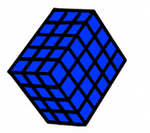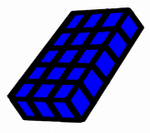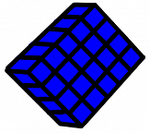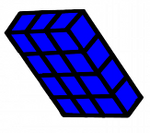Finding the Surface Area of a Rectangular Prism
|
Mentor: Can anyone tell me what surface area means? Student 1: Surface area is the number of square units that are needed to cover the surface of a three dimensional figure. Student 2: Surface area is just what you see of a three-dimensional object, not what is inside. Mentor: Good, how do you find the surface area of a three dimensional object? Student 1: Well, there are a lot of three dimensional objects such as cones, rectangular prisms and triangular prisms. The formula for finding surface area cannot be the same for all of these figures. Mentor: That is true! Three-dimensional figures have different formulas for surface area depending on their shape. Let's examine the surface area specifically of a rectangular prism.
Mentor: Since we are finding the surface area of this shape, how many sides will we need to include? Student 1: This is a rectangular prism so it has six sides. We have to make sure to count how many square units are on each of the six sides. That will give us the entire area that covers the shape. Mentor: Great! Let's first look at the top surface of this figure. How many square units cover this rectangular surface?
Student 2: There are 15 square units. Mentor: How did you find that? Student 2: I counted each square unit. Student 1: I got 15, too. I knew that to find the area of a rectangle you can multiply the length by the width so I multiplied the length (5) by the width (3). Mentor: That is right. You can find how many square units there are in a rectangle either by counting each one or by multiplying the length by the width. Now, are there any other surfaces on this rectangular prism that would be identical to the one we just worked with? Student 1: The surface directly below this (the base of the rectangular prism) should have the same amount of square units. Mentor: That is true, but why? Student 2: Well, the width of the flat rectangular shape will be the same (3) and the length of the shape will be the same (5) so that means that the area should be the same as well! Student: Good. Now we have two of the surfaces covered (each fifteen square units). Let's move to the side of the shape facing towards the right. How many square units are on this surface?
Student 1: There are 20 square units on this surface! Mentor: Good. And is there another surface identical to this one on the rectangular prism? Student 2: Yes, the surface directly opposite of this one would be identical since it, too, would have a length of five and a width of four. Mentor: Excellent. Now we have four surfaces covered. Two of them are 15 units each, and two of them are 20 units each. Lets take a look at the last side that we can see of this three dimensional figure:
Student 1: This surface has 12 square units. Student 2: Plus, another surface identical to it would be on the other side of the rectangular prism. That means there are two surfaces with 12 square units. Student: Right! So we have:
We have found the area of six surfaces and rectangular prisms have six surfaces so that means that we have found all that we need. Now, what is the total surface area of the rectangular prism? Student 1: To find the total surface area I would need to add all of the separate areas that I found together. It would be:
Mentor: Great job! You just found the surface area of a rectangular prism! |




